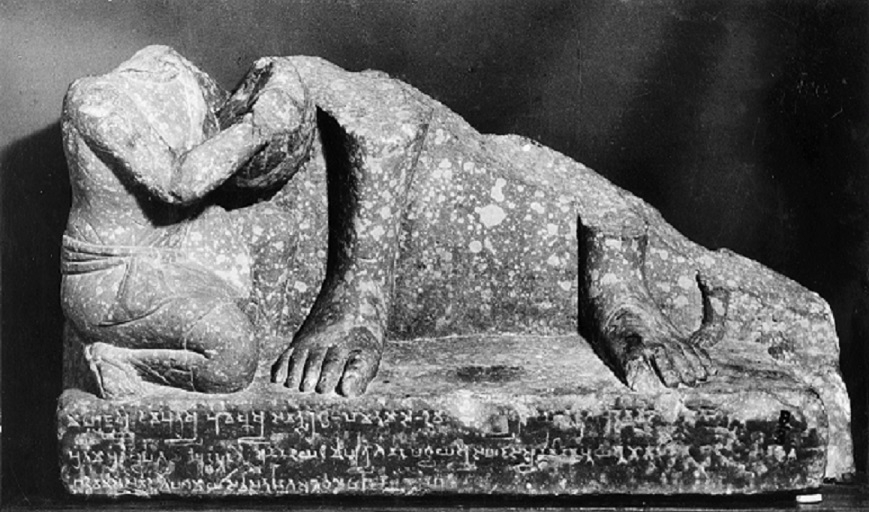Kuṣāṇa Donative Inscriptions
Many religious donations made during the Kuṣāṇa empire, ca. 50-320 CE, have inscriptions that contain the name of the ruler, a date, the donor, a description of the donation, and a list of people who benefit from the donation. Information in these texts have furnished scholars with crucial evidence about the religious, political, social, and economic conditions in South Asia during the Kuṣāṇa empire. This project builds on the data provided in these text by comparing selected Kuṣāṇa donative inscriptions across regions and between languages in an effort of better understand religious and cultural practices during the Kuṣāṇa empire.

In the first centuries of the Common Era images of religious figures entered the donative sphere alongside relics, stūpas, and architectural features. This burgeoning artistic period, centered in Gandhāra and Mathurā, coincides with the emergence of the Kuṣāṇas who connected the regions of what are now northern Indian, Northern Pakistan, Afghanistan into an integrated imperial unit. Many religious donations made during the Kuṣāṇa empire, ca. 50-320 CE, have inscriptions that contain the name of the ruler, a date, the donor, a description of the donation, and a list of people who benefit from the donation. Information in these texts have furnished scholars with crucial evidence about the religious, political, social, and economic conditions in South Asia during the Kuṣāṇa empire. This project builds on the data provided in these texts by comparing selected Kuṣāṇa donative inscriptions across regions and between languages in an effort of better understand religious and cultural practices during the Kuṣāṇa empire.
Significance
Due to the aesthetic appeal of religious images created in Gandhāra and Mathurā, comparisons between these schools have been a focus of many scholars of this period, but few have subjected the inscriptions that accompany these objects to a similar comparative framework. This project applies semantic and syntactic analysis of the donative formulas to compare ten epigraphs composed in the Gāndhārī language and Kharoṣṭhī script with sixteen written in Epigraphical Hybrid Sanskrit [EHS] and Brāhmī script. The READ platform is particularly suited to making these textual comparisons, and we anticipate that a thorough assessment of the formulae structure will generate a better understanding of donative practices in the Kuṣāṇa period and highlight relationships between epigraphic traditions in Gandhāra and Northern India. The twenty-six inscriptions analyzed in this project are primarily Buddhist with representative Jain, Nāga, Indic, and Imperial donations; a spectrum that will assist in identifying similarities and differences in donative formulas outside of the Buddhist context. Furthermore, the inscriptions chosen in this study range from earliest (56 CE) to latest (268 CE), and we will utilize the paleographic features of READ to help clarify dating issues between inscriptions composed in the first or second Kuṣāṇa century.
Collection
The Kuṣāṇa donative inscriptions in this project consist of sixteen EHS/Brāhmī inscriptions found at Mathurā and ten Gāndhārī/Kharoṣṭhī inscriptions. These inscriptions have been selected based on the coherence of the epigraph, clarity of the image, type of donation documented, and historical relevance.
Formulae Analysis
The approach implemented in this study of Kuṣāṇa donative inscriptions augments detailed philology with text structure, donative formulae and analysis of paleographic features. Collaboration on the development of these distinct strata of analysis is managed with READ Workbench.
The application of an internally coherent formulae ontology (a synthesis of the semantic and the syntactic) provides the substrate for an algorithmic generation of formulae type and a rich characterization of genre across this small-scale sampling of Kuṣāṇa donative and relic inscriptions. The visualization of formula sequences, both within the context of an inscription, and compared across the collection, provides an analysis tool to identify inflection points and pattern anomalies against normative types: data visualization as an iterative pattern analysis and ontology design practice.
The implementation of the formulae methodology across this disparate collection required ontology refinements to the to encompass different regions and languages, a process that facilitates the comparisons made in this study. Combining this refined ontology with the paleography compiled from the selected Kuṣāṇa donative inscriptions will serve as the basis for a more comprehensive study of the two hundred and ninety-five texts that comprise the Kuṣāṇa epigraphic corpus.
Digital Editions
The digital editions included in this collection are ‘cubed’ texts. This approach builds subsequent editions through a process of cloning and editing from an initial reference edition substrate and exposes scholarly innovation at its most granular. This homage to historical scholarship, where scholarly contribution is encapsulated in the provenance of each akṣara, syllable, token and compound provides a platform for research innovation. Contemporary collaborators can clone and develop a new edition with their own interpretations which may comprise new readings and/or a mash-up of previous editions. The renditions included in this collection for each edition include:
- Transliteration: Image and transliteration.
- Glossary: Image, transliteration, and glossary.
- Translation: Translation, and chāyā.
- Script: Image, transliteration, and script chart
- Structure: Visualize the text and formulae structure.
- TEI: Transliteration in EpiDoc TEI format.
- HTML: Transliteration in HTML format.

